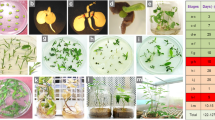Abstract
The apple rootstock Jork 9 was transformed using four different Agrobacterium rhizogenes virulent strains. The mannopine strain 8196 gave the best results in the production of chimeric plants compared to two agropine strains (A4 and 15834) and one cucumopine strain. Shoot regeneration was performed on both untransformed and transformed roots. Optimum combination and concentration of thidiazuron (TDZ) and α-naphtaleneacetic acid (NAA) was different between untransformed and transformed roots. From the transformed roots seven shoots were obtained and propagated as individual clones. All shoots from these clones rooted on a hormone-free medium contrary to untransformed shoots that did not root under similar culture conditions. Differences in the morphology of the leaves and stems were observed between the clones. The transformed status of the different clones was verified with mannopine tests, PCR and Southern blot analyses. Five clones contained the mas1', the ORF 13 and the rolB genes, whereas two clones contained only the rolB gene.
Similar content being viewed by others
References
Aldrich J & Cullis Ch (1993) RAPD Analysis in flax: Optimisation of yield and reproducibility using KlenTag1 DNA polymerase, Chelex 100 and gel purification of genomic DNA. Plant Mol. Biol. Rep. 11: 128–141
Caboni E, Lauri P, Tonelli M, Falasca G & Damiano C (1996) Root induction by Agrobacterium rhizogenes in walnut. Plant Sci. 118: 203–208
Chilton MD, Tepfer DA, Petit A, David C, Casse-Delbart F & Tempé J (1982) Agrobacterium rhizogenes inserts T-DNA into the genome of the host plant root cells. Nature 295: 432–434
Comai L, Facciotti D, Hiatt WR, Thompson G, Rose RE & Stalker DM (1985) Expression in plants of a mutant aro A gene from Salmonella thyphimurium confers tolerance to glyphosate. Nature 317: 741–744
David C, Chilton MD & Tepfer D (1984) Conservation of T-DNA in plants regenerated from hairy root cultures. Biotech. 2: 73–76
Hansen G, Larribe M, Vaubert D, Tempé J, Biermann BJ, Montoya AL, Chilton MD & Brevet J (1991) Agrobacterium rhizogenes pRi8196 T-DNA: mapping and DNA sequence of functions involved in mannopine synthesis and hairy root differentiation. Proc. Natl. Acad. Sci. USA 88: 7763–7767
Jensen JS, Marcker KA, Otten L & Schell J (1986) Nodule-specific expression of a chimaeric soybean leghaemoglobin gene in transgenic Lotus corniculatus. Nature 321: 669–674
Lambert C & Tepfer D (1991) Use of Agrobacterium rhizogenes to create chimeric apple trees through genetic grafting. Biotech. 9: 80–83
Lambert C & Tepfer D (1992) Use of Agrobacterium rhizogenes to create transgenic apple trees having an altered organogenic response to hormones. Theor. Appl. Genet. 85: 105–109
Miltenburg van R, Ruger B, Grunewald-Janho S, Leons M & Schröder Ch (1995) The DIG system User's Guide for Filter Hybridization. Boehringer Mannheim GmbH, Biochemica
Moore L, Warren G & Strobel G (1979) Involvement of a plasmid in the hairy root disease of plants caused by Agrobacterium rhizogenes. Plasmid 2: 617–626
Murashige T & Skoog F A (1962) Revised medium for rapid growth and bioassays with tobacco tissue cultures. Physiol. Plant. 15: 473–497
Nakano M, Hoshino Y & Mii M (1994) Regeneration of transgenic plants of grapevine(Vitis vinifera L.) via Agrobacterium rhizogenes-mediated transformation of embryogenic calli. J. Exp. Bot. 45: 649–656
Pawlicki N & Welander M (1995) Influence of carbohydrate source, auxin concentration and time of exposure on adventitious rooting of the apple rootstock Jork 9. Plant Sci. 106: 167–176
Petit A, David Ch, Dahl GA, Ellis J & Guyon P (1983) Further extension of the opine concept: plasmids in Agrobacterium rhizogenes cooperate for opine degradation. Mol. Gen. Genet. 190: 204–214
Riker AJ, Banfield WM, Wright WH, Keith GW & Sagen HE (1930) Studies on infectious hairy-root of nursery apple tree. J. Agric. Res. 41: 507–540
Rugini E & Mariotti D (1991) Agrobacterium rhizogenes T-DNA genes and rooting in woody species. Acta Hort. 300: 301–308
Rugini E, Pellegrineschi A, Mencuccini M & Mariotti D (1991) Increase of rooting ability in the woody species kiwi (Actinidia deliciosa A. Chev.) by transformation with Agrobacterium rhizogenes rol genes. Plant Cell Rep. 10: 291–295
Sambrook J, Fritsch E & Maniatis T (1989) Molecular Cloning: A Laboratory Manual. Cold Spring Harbor Laboratory Press, Cold Spring Harbor, New York
Slightom JL, Durant Tardif M, Jouanin L & Tepfer D (1986) Nucleotide sequence analysis of TL-DNA of Agrobacterium rhizogenes agropine type plasmid: identification of open reading frames. J. Biol. Chem. 261: 108–121
Spena A, Schmulling T, Koncz C & Schell JS (1987) Independent and synergistic activity of rol A, B and C loci in stimulating abnormal growth in plants. EMBO J. 6:3891–3899
Strobel G, Nachmias A, Satouri S & Hess W(1988) Improvements in the growth and yield of olive trees by transformation with the Ri plasmid of A. rhizogenes. Can. J. Bot. 66: 2581–2585
Tepfer D (1984) Transformation of several species of higher plants by Agrobacterium rhizogenes sexual transmission of the transformed genotype and phenotype. Cell 37: 959–967
Tepfer M & Casse-Delbart F(1987) Agrobacterium rhizogenes as a vector for transforming higher plants. Microbiol. Sci. 4: 24–28
Trulson AJ, Simpson RB & Shahin EA (1986) Transformation of cucumber (Cucumis sativus L.) plants with Agrobacterium rhizogenes. Theor. Appl. Genet. 73: 11–15
Welander M, Pawlicki N, Holefors A & Wilson F (1998) Genetic transformation of the apple rootstock M26 with the rolB gene and its influence on rooting. J. Plant Physiol. 153: 371–380
White F, Ghidossi G, Gordon M & Nester E (1982) Tumor induction by Agrobacterium rhizogenes involves the transfer of plasmid DNA to the plant genome. Proc. Natl. Acad. Sci. USA 79: 3193–3197
Zhu LH, Holefors A, Ahlman A, Xue ZT & Welander M (2001) Transformation of the apple root stock M9/29 with the rol B gene and its influence on rooting and growth. Plant Sci. 160: 433–439
Author information
Authors and Affiliations
Corresponding author
Rights and permissions
About this article
Cite this article
Pawlicki-Jullian, N., Sedira, M. & Welander, M. The use of Agrobacterium rhizogenes transformed roots to obtain transgenic shoots of the apple rootstock Jork 9. Plant Cell, Tissue and Organ Culture 70, 163–171 (2002). https://doi.org/10.1023/A:1016387004712
Issue Date:
DOI: https://doi.org/10.1023/A:1016387004712




